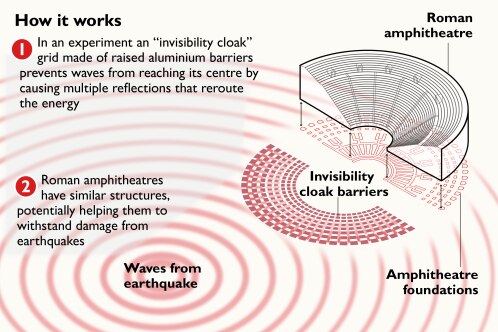How rise of quake-proofing stopped fall of Roman empire
Advanced anti-seismic engineering may have to be added to the rest in the list of what the Romans did for us.

Advanced anti-seismic engineering may have to be added to “sanitation, medicine, education, wine, public order, irrigation” and the rest in the list of what the Romans did for us.
Engineers say that celebrated Roman buildings may have survived thanks to seismic “invisibility cloaks” that protect them from earthquake damage.
Complex structural features of Roman amphitheatres and theatres could explain how the Colosseum and other arenas have remained standing despite their proximity to fault lines.
The observation came from engineers and academics in France who were studying how to use grids of objects above or below the ground to protect buildings and districts from tremors. Their designs are inspired by small modern “cloaking” devices that deploy a geometric array of barriers to stop electromagnetic or other waves reaching a particular area. In examining how grids of columns or holes in the ground could channel seismic energy so as to reduce shaking in structures, they found that their Gallo-Roman forebears may have beaten them to it millennia ago.
Stephane Brule, of Menard civil engineers, one of the authors of the study, was visiting the ruins of Augustodunum at Autun, near Dijon, when he noticed that the structure of the Roman-era theatre bore a remarkable resemblance to modern “metamaterials” designed to disrupt waves of energy. Metamaterials have been likened to the invisibility cloaks of science fiction because of their ability to disrupt energy waves and create undetectable blind spots.

Dr Brule then superimposed plans of the theatre’s foundations on diagrams of a disc-shaped cloaking device that his colleagues had designed to shield an area from electromagnetic and other waves. He found that the columns matched almost exactly elements of the cloaking device, with both arranged in concentric circles that get closer together as they get nearer to the centre. Dr Brule found the same alignment in the foundations of the Colosseum and other amphitheatres and theatres. Specifically, he found that the relative spacing of the concentric circles, semicircles or ellipses was near-identical.
He and his co-authors, a mathematician and physicist at the Institute Fresnel, believe that grids of columns or holes in the ground can protect buildings from seismic waves by causing multiple reflections in the energy which have the effect of reducing shaking in a structure or enclosed area.
Dr Brule told Physics World that the Roman design could have evolved as a result of building in highly seismic regions, or may have been coincidence in that the designs best suited to bearing the relevant loads happened to function as earthquake breakers.
The Romans are celebrated for their engineering. The Colosseum, started by the emperor Vespasian in AD70, was damaged by earthquakes in the 400s and 1300s but mostly still stands.
The ideal Roman architect was a polymath, described by the architect and engineer Vitruvius as “a man of letters, a skilful draftsman, a mathematician, familiar with historical studies, a diligent student of philosophy, acquainted with music, not ignorant of medicine, learned in the responses of jurisconsults, familiar with astronomy and astronomical calculations.”
Knowledge of sophisticated design principles to protect against earthquakes has also been ascribed to the ancient Greeks and modern engineers study the Parthenon’s survival through almost 2500 years in quake-prone Athens.
In their paper in the preprint journal arXiv, the researchers said that architects, engineers and planners today could learn from the “beautiful” and “amazingly resilient” Roman designs when creating new buildings for seismic areas. Although the team has used computer models, it intends to test its theory on the ground using grids of concrete piles in the “Roman” layout.
The Times



To join the conversation, please log in. Don't have an account? Register
Join the conversation, you are commenting as Logout